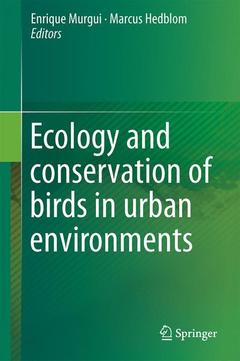Ecology and Conservation of Birds in Urban Environments, Softcover reprint of the original 1st ed. 2017
Coordonnateurs : Murgui Enrique, Hedblom Marcus

This book provides syntheses of ecological theories and overarching patterns of urban bird ecology that have only recently become available. The numerous habitats represented in this book ranges from rows of trees in wooded alleys, to wastelands and remnants of natural habitats encapsulated in the urban matrix. Authored by leading scientists in this emergent field, the chapters explore how the characteristics of the habitat in urban environments influence bird communities and populations at multiple levels of ecological organization and at different spatial and temporal scales, and how this information should be incorporated in urban planning to achieve an effective conservation of bird fauna in urban environments.
Birds are among the most conspicuous and fascinating residents of urban neighborhoods and provide urban citizens with everyday wildlife contact all over the world. However, present urbanization trends are rapidly depleting their habitats, and thus knowledge of urban bird ecology is urgently needed if birds are to thrive in cities.
The book is unique in its inclusion of examples from all continents (except Antarctica) in an effort to arrive at a more holistic perspective. Among other issues, the individual chapters address the censusing of birds in urban green spaces; the relationship between bird communities and the structure of urban green spaces; the role of exotic plant species as food sources for urban bird fauna; the influence of artificial light and pollutants on bird fauna; trends in long-term urban bird research, and transdisciplinary studies on bird sounds and their effects on humans. Several chapters investigate how our current knowledge of the ecology of urban bird fauna should be applied in order to achieve better management of urban habitats so as to achieve conservation of species or even increase species diversity. The book also provides a forward-looking summary on potential research directions. As such,it provides a valuable resource for urban ecologists, urban ecology students, landscape architects, city planners, decision makers and anyone with an interest in urban ornithology and bird conservation. Moreover, it provides a comprehensive overview for researchers in the fields of ecology and conservation of urban bird fauna.
Enrique Murgui
After he graduated as biologist in 1992 Enrique has been involved in every sort of ornithological projects from censusing bird fauna in uplands to collaborate in several NGOs, and giving professional assistance to different firms. In 2006 he received his PhD dealing with the influence of urban landscape structure on bird fauna. Since then he has been involved in a long-term research on how urbanization affect bird fauna across time, and in other research and professional projects ranging from an investigation on peri-urban farmland bird communities to monitoring bird fauna in windfarms.
Marcus Hedblom
Marcus received his PhD in 2007 concerning birds and butterflies in urban and peri-urban habitats. He has since then worked as a nature conservation strategist in the fourth largest city in Sweden (Uppsala), made a post-doc at Gothenburg University and worked as a project leader at the national monitoring program for biodiversity (NILS) at the Swedish University of Agricultural Sciences (SLU). He is presently involved in numerous transdisciplinary research projects concerning urban ecosystem services and leader of a research group studying human stress reduction from natural sounds in cities at SLU. Marcus is an associate editor of the Journal Urban Ecosystems and founder of the Swedish Think tank Green City.
Date de parution : 02-2017
Ouvrage de 525 p.
15.5x23.5 cm
Date de parution : 07-2018
Ouvrage de 525 p.
15.5x23.5 cm



